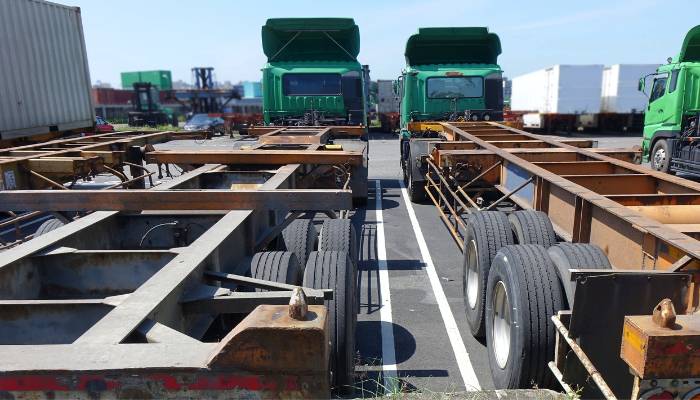
Intermodal container chassis are a type of semi-trailer used to transport intermodal containers, also called shipping containers. These trailers are designed to be loaded onto a railway wagon or a ship and are typically used to move cargo from one form of transportation to another.
Intermodal container chassis have a deck that is designed to hold a container securely and safely. The chassis has a frame, axles, and wheels, and can be towed by a truck or tractor. The chassis is designed to be able to travel on both roads and railways, and some models can also be fitted with a crane for loading and unloading containers.
Types of intermodal container chassis
The basic type of chassis is the single-drop chassis, which is typically used for short hauls. Bull Chassis, a manufacturer of port chassis and ocean containers, states that this type of trailer is designed to carry one container and has two axles with four wheels, two on each axle. The container is loaded onto the chassis via a rear-mounted ramp, and it is secured with straps and chains.
- Double-drop chassis: The double-drop chassis is another type of intermodal container chassis. This type of trailer is designed to carry two containers at the same time, and it has four axles and eight wheels. The two containers are loaded onto the chassis via a rear-mounted ramp, and they are secured with straps and chains.
- Flatbed container chassis: The flatbed container chassis is another type of intermodal container chassis. This type of trailer is designed to carry one container, and it has four axles and eight wheels. The container is loaded onto the chassis via a side-mounted ramp, and it is secured with straps and chains.
- Extendable container chassis: The extendable container chassis is another type of intermodal container chassis. This type of trailer is designed to carry two containers at the same time, and it has six axles and twelve wheels. The two containers are loaded onto the chassis via a side-mounted ramp, and they are secured with straps and chains.
- Folding container chassis: The folding container chassis is another type of intermodal container chassis. This type of trailer is designed to carry two containers at the same time, and it has four axles and eight wheels. The two containers are loaded onto the chassis via a side-mounted ramp, and they are secured with straps and chains. This type of trailer is designed to fold down when not in use, making it very efficient in terms of space.
- Flatrack container chassis: Flatrack container chassis is another type of intermodal container chassis. This type of trailer is designed to carry two containers at the same time, and it has four axles and eight wheels. The two containers are loaded onto the chassis via a side-mounted ramp, and they are secured with straps and chains. This type of trailer is designed to be loaded and unloaded from the side, making it ideal for loading and unloading containers from ships in harbors.
How to choose intermodal container chassis?
Thinking before choosing an intermodal container chassis is important because it will determine the overall success of the transportation process. The right chassis can increase efficiency, reduce damage, and ensure that shipments arrive on time and in good condition. Furthermore, using the wrong chassis can result in higher costs, delays, and even lost shipments. Additionally, the wrong chassis can lead to problems with compatibility and safety. Therefore, it is important to think before choosing an intermodal container chassis in order to ensure a successful, cost-effective, and safe transportation process.
- Determine the type of container you will be hauling. Intermodal container chassis types are designed to accommodate different sizes and types of containers, such as 20-foot, 40-foot, and 45-foot containers.
- Consider the weight of the container and the chassis. Different types of containers and chassis can have different weight capacities.
- Consider the overall dimensions of the container and the chassis. This will help you determine if the container and chassis will fit within the parameters of the route you will be taking.
- Consider the type of freight you will be carrying. Some chassis are designed for specific types of freight, such as hazardous materials or perishable goods.
- Consider the type of suspension required for the container and chassis. Different types of suspension are available, from air suspension to spring suspension.
- Consider the type of brakes that the container and chassis will need. Different types of brakes are available, such as disc brakes, drum brakes, and air brakes.
- Consider the type of tires that will be installed on the container and chassis. Different types of tires are available, such as radial tires and bias ply tires.
- Consider the type of fuel that will be used to power the container and chassis. Different types of fuel are available, such as diesel and natural gas.

